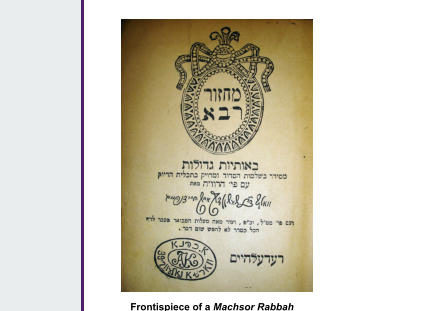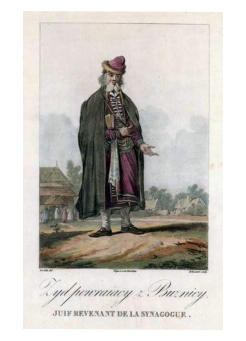


Compiled by Martin Davis © 2016
Frontispiece of a Machsor Rabbah
(holy day liturgy and poems)
published in Warsaw and used in
Szczerców from 1840
Sources
1. Outline of the History of Szczerców - 1332-1945 by Zbigniew M. Glab publish at http://www.historycznie.uni.lodz.pl/szczercow.htm
2. Szczerców: The Encyclopaedia of Jewish Communities, Poland, (Pinkas Hakehillot Polin) Volume I, pages 88-89 - published by Yad Vashem,
Jerusalem. Translation by Morris Wirth

In 1869 it lost its charter town status - possibly as a punishment of the town leaders for their part in the earlier
uprising. The poverty was also visible in the buildings which were made of wood and regularly damaged by fire, and
the streets which were unpaved. In the 1860s report it mentions that only four homes were made of brick. In 1880 one
of the regularly occurring fires destroyed 84 residential buildings and businesses; estimated at about one third of the
total.
The Shtetl’s Early Development
Community Life
The Jewish community built its synagogue in the 1830s; located on the left hand side of Czestochowa Street going towards the old bridge over the river Widawka. No information is currently available as to its design or size. The synagogue was destroyed in the defence of Szczerców in 1939. On the opposite side of the road to the synagogue and above the Jewish bank was the Talmud Torah (Jewish school) - this building still exists and is today a Municipal Health Centre. The Jewish community also had its own cemetery; the remnants of which are located near the village of Brzezie . According to Zbigniew M. Glab1, the cemetery survived the German occupation but has seen a gradual deterioration as its brick walls were demolished, which along with the matzevot (tombstones), were used as materials in the reconstruction of Szczerców. At first, the Jews of Szczerców were part of the Łask community. In the second half of the 19th century they set up their own independent community. During the period between the two world wars Agudat Israel ran the local authority, sometimes elected on a block vote with the Trade Unions.2 In the mid 1800’s the named rabbi was Rabbi Izrael Szmulowicz Erlicher. At the end of the 19th century and the beginning of the 20th, a Rabbi Neta, and after him Rabbi Meir, are mentioned as the rabbis of the Szczerców Jewish community. In 1912, the acting rabbi was then a dayan [judge] named Rabbi Yitzhak Meir Koltonowski, the son of Rabbi Avraham Binyamin, the rabbi of the community of Widawa. In the period between the two world wars, Rabbi Majer Ejbeszyc held the post, and after him, Rabbi N. Ejbeszyc - the last rabbi to serve the community.A Schedule of Disasters
At the end of the 19th century and during the period between the two world wars, the town experienced many disasters. On three occasions fires broke out and houses, including many belonging to Jewish families, were burnt down. In 1880, 80 buildings were destroyed by fire. On August 8, 1935, a fire laid waste over 120 houses, and nearly 1,000 people, among them 120 Jewish families (over 530 people) were made homeless. Apparently the regional authorities were so moved that they donated 1,000 zloty for the relief of the poor. Szczerców suffered severely during the Polish economic depression which lasted from 1924 to 1934. In 1935 disaster struck again when the town caught on fire and half the residential buildings were destroyed. This was followed by a further fire in September 1936 when further damage occurred. It was observed that on the eve of the Second World War the Jews of Szczerców were utterly poverty stricken due to continuous natural disasters, the town's serious economic problems, and the increasing economic boycott of Jewish businesses.2An Ancient Town
The first mention of Szczerców dates from 1332 when King Casimir the Great granted the local church taxation rights; although an earlier medieval cemetery in the area attests to an earlier date of settlement. The village was granted a town charter with market and fair holding rights in 1364. Szczerców remained a small settlement throughout its history and because of its location, near major transport routes, the residents were exposed to the dangers of military marches and military operations. For example, Szczerców was destroyed during the Swedish Deluge (Swedish invasion of Poland) in the mid- seventeenth century. In 1781, a regional commission submitted a plan to the Sieradz province to make it economically active (including including the establishment of a weaving factory), but this plan was never realized. Matters did not improve and this was observed in a report of the county authority in the 1860s. To make matters worse Szczerców, like many other towns in the Łódź region became the victim of Tsarist repression after the January Uprising of 1863.

A significant number of Jewish families are identified In the military census of
‘Jews of the parishes and settlements belonging to the Jewish Commune of
Dzialsozyn’, undertaken in 1765. In this census11 household were identified in
the parish of Szczerców totalling 52 men women and children. Only one person
was identified with a trade (Elias Majorowicz - tailor) but all were eligible to pay
tax. The numbers at this early date would suggest that the Jewish community
was established prior to 1765. Szczerców was at that time and remained a
royal city until 1793.
In about 1790, Jewish families began to settle in increasing numbers in
Szczerców. The origins of the families are not identified currently but they were
likely to have been from adjacent privately owned villages and towns in the
area. Commonly, Jewish families who had been excluded from royal or church
owned towns and villages, such as Szczerców, in earlier periods, resettled in
those towns when the second partition of Poland occurred in 1790. At that time
there were 124 houses in the village.
There were a total of 16 adult Jews recorded in the village at the Prussian
census of 1792. Of those one family made a living as inn keepers, another was
a shopkeeper, plus a butcher, two bakers and two tailors.
During the early 1800s the village experienced a rapid expansion. By 1820,
there were a total of 159 houses and 1,064 inhabitants (including 149 Jews).
The membership of the pre 1825 Jewish community is known and can be
gauged by reviewing the patronymic page on this site.
Polish Jew - Dressed for
Synagogue circa 1810
Click to enlarge image
Click to enlarge image















